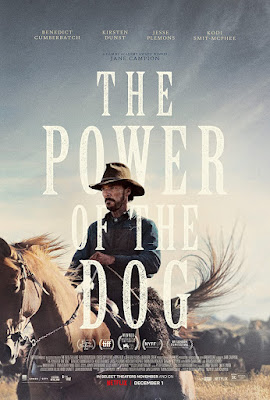Jane Campion’s new The Power of the Dog, can fairly be described as a mystery. Which by no means suggests that it’s a classic whodunit, with dark deeds committed early on and the perpetrator unmasked just before the lights come up. There’s certainly darkness in this movie, but emphasis in The Power of the Dog is squarely on the mystery of the human soul. As in Campion’s long-ago 1993 triumph, The Piano, the new film is peopled by characters who act in ways we don’t always understand. Two moviegoers can come away from it with entirely different perspectives on what just happened on screen. My filmgoing companion turned to me afterwards and said, “Well, I didn’t see that coming.” And I admit that my own first thoughts were quite different from the well-reasoned conclusion he’d reached. There’s no shame in needing to watch The Power of the Dog more than once. This is a film that offers huge rewards to those paying close attention.
Partly that’s because Campion is such a visual stylist. Without ever becoming heavy-handed, she draws our attention to places and objects that have their own quiet significance in the tale being told. As in The Piano, the landscape is definitely part of the story. In the earlier film it was the wild New Zealand coastline. Here it’s New Zealand again, standing in for the chilly plains and rocky hills of Montana, circa 1920. The realistic close-ups of cowboys going about their daily work move the film squarely into the Western genre, but there’s an effective juxtaposition with the film’s traces of modernity, including the rare automobile and flapper-length skirts. The clash between past and present is essential to the story being told, somewhat as in Kirk Douglas’s fascinating Lonely are the Brave.
But things, as well as places and time-frames, also have their significance. I don’t believe an at-home viewing on a television screen can fully introduce us to inanimate objects that, through dramatic closeups, play a key part in the unfolding drama. Hand-made paper flowers, a braided leather rope, a monogramed scarf, gleaming white tennis sneakers—these mundane items become hugely important over the course of the story. Equally important is the mysterious title that only makes its meaning felt at the film’s very end. Its source is a Biblical passage (Psalm 22:20 --“Rescue my soul from the sword, my essence from the grip of the dog”) that at first seems unrelated to the matters at hand. Certainly, this is not a dog story. It’s only in the context of all that’s gone before that we can find a shred of meaning in these mysterious but evocative words.
I’ve stalled in mentioning the film’s chief actors, all of whom make an indelible impression. The protean Benedict Cumberbatch is front and center, playing Phil Burbank, a roughneck type we don’t know whether to hate or pity. Jesse Plemons (so ominous in Breaking Bad) here conveys a very different type, the gentle, civilized brother who becomes the object of Phil’s ongoing scorn. The always welcome Kirsten Dunst sinks her teeth into the role of the new wife, fragile but ultimately sturdy. If all of the above sounds like something from Steinbeck (East of Eden) or maybe Tennessee Williams, Campion has a few surprises up her sleeve. I also need to mention a relative newcomer to American films, Australian Kodi Smit-McPhee, as Dunst’s gawky, introspective son. In a L.A. Times interview, Smit-McPhee gives his own clearcut view of the film’s ambiguous ending. If you read it prior to seeing this mesmerizing movie, you’ll be sorry.








No comments:
Post a Comment